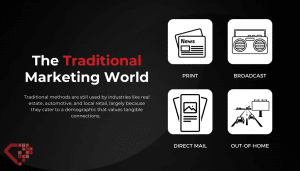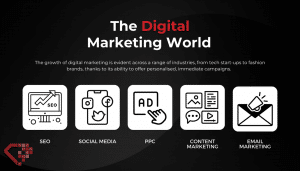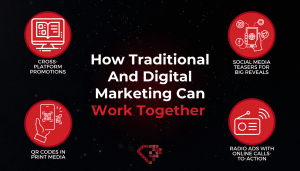Navigating the marketing landscape, businesses have often found themselves making choices between traditional strategies and the enticing opportunities of digital marketing.
Yet, it’s not always about choosing one over the other. In many instances, it’s about understanding how they can complement and enhance each other to craft a cohesive brand narrative. To fully appreciate their synergistic potential, one must first grasp the difference between traditional marketing and digital marketing.
The transformation from traditional to digital marketing has been nothing short of revolutionary, redefining how companies connect with their audiences. However, as the digital frontier expanded, it didn’t diminish the value of traditional mediums. Instead, it presented an opportunity for them to coexist, complementing and enhancing each other’s strengths.
At Ruby Digital, we’re not just well-versed in the nuances of digital marketing, but we also deeply respect and understand the foundations of traditional marketing. This dual insight enables us to bridge the gap effectively, ensuring that our clients reap the benefits of both worlds.
The Traditional Marketing World?
One of the primary digital marketing and traditional marketing differences lies in the mediums themselves. Traditional marketing, which includes mediums like billboards, radio spots, television commercials, and print advertisements, has been the cornerstone for businesses aiming to reach audiences for decades. These techniques, rooted deeply in our local South African culture, continue to evoke emotions and play a significant role in influencing purchasing decisions.
Traditional marketing takes various forms:
- Print: Newspapers, magazines, and brochures have always been reliable mediums to convey messages.
- Broadcast: TV and radio commercials continue to have a wide reach, especially during prime time.
- Direct Mail: Personalised postcards, catalogues, and letters target specific demographics.
- Out-of-Home: Billboards, posters, and transit advertisements are hard to miss in urban landscapes.
Of these, television commercials still reign supreme, owing to their ability to combine visual storytelling with a broad audience reach. Specifically to the South African context, radio adverts also still play a key role, as they’re able to reach customers who might not have access to television.

Pros and Cons of Traditional Marketing:
Looking at traditional vs digital marketing, it’s crucial to weigh the benefits and drawbacks of each. Starting with traditional marketing…
Pros:
- Tangible: Physical ads can be touched and felt, enhancing recall.
- Local Audience Reach: Local newspapers or radio stations can effectively target a regional audience.
- Easier Understanding: Often less convoluted than digital strategies, making them more accessible to certain demographics.
Cons:
- Cost: Often more expensive than their digital counterparts.
- Limited Engagement: Unlike digital platforms, there’s minimal interaction between the audience and the advertisement.
- Measurement Challenges: It’s tougher to accurately measure the effectiveness of a traditional marketing campaign.
Despite the rise of digital platforms, industries like real estate, automotive, and local retail still leverage traditional methods, mainly because they cater to a demographic that values tangible connections and familiar outreach methods.
For instance, a local grocery store might find more value in distributing pamphlets with their current specials, ensuring they connect directly with their immediate customers. But what are the core advantages of digital marketing vs traditional marketing? Let’s dive into the digital realm to understand its unique benefits.
The Digital Marketing World?
Digital marketing, a realm that’s transformed the way businesses engage with their audiences, encompasses a wide range of strategies enabled by electronic technology. Whether it’s the allure of a well-crafted social media post, the precision of a targeted email campaign, or the global reach of a well-optimised website, digital channels provide unparalleled opportunities to connect and converse with customers.
Understanding Digital Marketing: At its core, digital marketing involves:
- Search Engine Optimisation (SEO): Fine-tuning websites to rank higher on search engines, thereby increasing organic visibility.
- Social Media Marketing: Leveraging platforms like Facebook, Instagram, LinkedIn, and Twitter to reach and engage with audiences.
- Pay-Per-Click (PPC) & Online Advertising: These are ads that appear on search engines, social media, and various online platforms, with costs determined by the number of clicks received.
- Content Marketing: Creating and promoting valuable content to attract, inform, and engage audiences.
- Email Marketing: Sending targeted communications to subscribers, leading to higher engagement and conversions.

Pros and Cons of Digital Marketing:
Pros:
- Measurability: Tools like Google Analytics provide real-time data on campaign effectiveness.
- Flexibility: Digital campaigns can be easily adjusted based on performance or changing business objectives.
- Targeted Outreach: Advertisers can focus on specific demographics, behaviours, or interests, ensuring relevance.
Cons:
- Competitive Landscape: The online world is saturated, making it challenging to stand out.
- Constant Evolution: Platforms and algorithms are ever-changing, requiring continuous learning and adaptation.
- Short Attention Spans: With an overflow of information, grabbing and retaining user attention is challenging.
Digital marketing’s growth is evident across a range of industries, from tech start-ups to fashion brands, largely because of its ability to offer personalised, immediate, and wide-reaching campaigns.
For instance, an e-commerce clothing brand might deploy Facebook Ads showcasing their latest collection, retargeting visitors who browsed their site but didn’t make a purchase. The real-time feedback allows the brand to tweak their messaging or offers, enhancing the chance of conversions.
How does digital marketing differ from traditional marketing?
Traditional marketing utilises physical channels like print, TV, and radio to reach audiences, often broadly. Digital marketing leverages online platforms and electronic devices, allowing for more precise targeting and real-time adjustments.
Advantages of digital marketing vs traditional marketing
- Measurability: Real-time analytics offer immediate insights.
- Flexibility: Campaigns can be adjusted on-the-fly based on performance.
- Targeted Outreach: Precise audience targeting based on demographics, behaviours, and interests.
- Cost-Effectiveness: Often more budget-friendly with a higher return on investment.
- Global Reach: Ability to engage with audiences anywhere, anytime.
- Interactivity: Enables two-way communication, fostering deeper engagement.
How Traditional and Digital Marketing Can Work Together
It’s a misconception that traditional and digital marketing are adversaries. In reality, they can join forces, bringing out the best in each other for a holistic approach that maximises brand exposure and engagement.
- Cross-Platform Promotions: Consider a television commercial that promotes an app download or guides viewers to an exclusive online contest. Such tactics not only maximise reach but also blend the immersive storytelling of TV with the interactive capabilities of digital platforms.
- QR Codes in Print Media: Modern print advertisements or brochures can include QR codes, bridging the physical-digital divide. Scanning the code can lead a customer to a product page, a special discount, or even augmented reality experiences.
- Social Media Teasers for Big Reveals: Brands can use social media platforms to tease upcoming events, product launches, or TV commercials. This generates buzz online and encourages audiences to tune into the television or radio broadcast.
- Radio Ads with Online Calls-to-Action: While a radio advert plays, it can prompt listeners to visit a specific website or join an online event, leveraging the wide reach of radio with the engagement capabilities of digital platforms.

Real-World Collaborations:
- Movie Trailers: Film studios release trailers online, urging viewers to book tickets on their website, and simultaneously broadcast them on TV to maximise reach.
- Product Launches: Brands often tease new product launches on social media, directing consumers to a live event broadcasted traditionally via television or radio.
- Festive Sales: Retail stores announce their festive sales on television but also push online exclusive deals, directing viewers to their e-commerce platforms.
Harnessing the strengths of both traditional and digital strategies offers a cohesive brand experience, ensuring no potential touchpoint with the customer is left unexplored. By integrating these strategies, brands can enjoy amplified benefits that wouldn’t be achievable if each method was used in isolation.
What Type of Marketing Works Best for You?
In today’s diverse marketplace, understanding which marketing avenue to pursue can feel like navigating a maze! The optimal route isn’t the same for everyone – it’s intricately tied to your brand’s goals, target audience, and industry dynamics.
- Digital Marketing’s Dominance: For many industries, especially those targeting younger demographics or a global audience, digital marketing is often the prime choice. The appeal is evident:
- E-commerce Businesses: With online shopping booming, companies in this space benefit immensely from digital ads, email marketing, and social media campaigns.
- Tech Startups: For brands offering software or app-based solutions, online platforms provide the perfect medium to showcase their innovations.
- Online Education & Courses: Given the virtual nature of their product, online promotions and advertising are integral.
- Traditional Marketing’s Resilience: Certain sectors still find traditional marketing indispensable, especially when targeting demographics that value tactile experiences or are less digitally inclined:
- Local Artisanal Brands: Craftsmen, boutique outlets, and farmers’ markets often resonate better with print adverts, local radio spots, or even community event sponsorships.
- Real Estate: While online listings are common, billboards, local newspaper features, and open house signs remain crucial promotional tools.
- Consumer Goods: For products catering to a broad demographic, TV commercials or in-store promotions can be more impactful.
- The Cohesive Approach: A blend of both strategies is increasingly becoming the gold standard. For instance, a bookstore might have a strong online presence with e-commerce capabilities, but also invests in local print ads or hosts book readings to engage their community.
Remember, it’s not about ranking one form of marketing over another but understanding how they can synergise for your unique needs. At Ruby Digital, we’ve witnessed the dynamism of this blend, helping businesses utilise the best of both realms.
The path to success is about being agile, observant, and receptive to the ever-evolving marketing landscape. Whether you lean heavily towards digital or remain rooted in traditional methods (or skilfully dance between the two!), the key is to remain authentic to your brand and attentive to your audience’s preferences.
Conclusion
In the vast landscape of the marketing world, traditional and digital strategies are not disparate paths, but rather intertwining routes that can lead businesses to the same destination: success. The synergy between digital marketing and traditional marketing offers an expansive toolkit for brands, allowing them to tap into varied audiences and maximize their reach.
Both methods offer their unique benefits, presenting options for companies to engage, connect, and grow in various ways. Digital marketing, with its data-centric approach and global reach, equips businesses with tools to tap into modern audiences and their ever-evolving preferences. On the flip side, traditional marketing continues to hold its ground, offering a reliable and familiar touchpoint, especially for local and niche markets.
At Ruby Digital, we believe in a holistic approach. Recognising the potential of both avenues and integrating them offers a comprehensive solution that addresses the needs of a diverse audience. Our work, which spans from local to global campaigns, is a testament to this integrated philosophy.
Whether you’re a local enterprise looking to expand digitally, or a new brand seeking to establish a foothold, remember that combining the strengths of traditional and digital marketing can create a more robust and impactful strategy.
For more insights, check out our article on the battle between digital and traditional marketing. Let’s chart the path to marketing excellence together!



